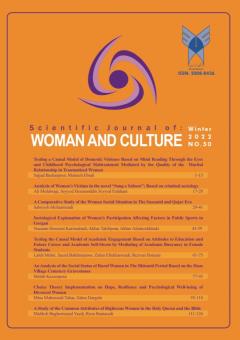مطالعه تطبیقی اوضاع اجتماعی زنان در دوره ساسانی و قاجار
الموضوعات :
1 - دانشگاه پیام نور همدان، گروه تاریخ(تاریخ ایران اسلامی)، همدان، ایران.
الکلمات المفتاحية: اوضاع اجتماعی زنان, دوره ساسانی, دوره قاجار,
ملخص المقالة :
هدف پژوهش حاضر تطبیق نقش اجتماعی زنان در ادوار ساسانی و قاجار بود. جامعه پژوهش نقوش زنان در آثار هنری، چون سکهها و نقاشیها را شامل میشود. نمونه پژوهش پوشش زنان ساسانی و قاجاری در دادههای فرهنگی این ادوار بود. طرح پژوهش از نظر ماهیت، توصیفی ـ تاریخی و تطبیقی است. گرد آوری اطلاعات برمبنای جمعآوری اطلاعات کتابخانهای ، اسناد و مدارک موجود و فیشبرداری انجام گرفت. پس از جمع آوری داده ها برای تحلیل آن ها از روش کیفی استفاده شد. نتایج یافته ها نشان داد، زنان در هر دو دوره، با قرائتها و خوانشهای فقهی خاص از دین رسمی زمان خود مواجه بوده و در هر دو مرحله نیز مهیای پذیرش تغییرات کلان بُرونی بودند. در مورد نخستین، اسلام و در مورد دومین، موج جهانیسازی و مدرنیسم وارد شد و جایگاه زنان را با تغییراتی روبروکرد. زنان با اینکه در دو دوره ساسانی و قاجار محدودیتهایی داشتند، اما در لایه های نامرئی اجتماع، به کنشگری، فعالیت اجتماعی و حتی اثرگذاری در امور مهم حکومتی میپرداختند. در دوره ساسانیان، این نقش تا حدود زیادی آشکار و شفاف بود؛ اما در دوره قاجار، آنان برای انجام خواستههای خویش ناگزیر بودند که خواسته خود را با واسطه مردان و اثرگذاری نقش جنسیتی خود اجرا کنند.
Alawi, H. (2007). Woman in Ancient Iran. Tehran: Helmand Publications. [Persian]. URL: https://hirmandpublication.com/product/
Boozer Jamhari, M. (2015). Women's titles in the Qajar era (based on national archival documents). National Archives quarterly, 2(1), 36-51. [Persian] URL: chrome-extension://efaidnbmnnnibpcajpcglclefindmkaj/viewer.html?pdfurl
Daryaee, T. (2008) Sassanid Empire. Translated by Morteza Sagheb. (2020). Tehran: Phoenix Publications. [Persian]. URL: https://qoqnoos.ir/Fa/
Delrish, B. (1996). Woman in the Qajar Period. Tehran: Office of Religious Studies of Art. [Persian] URL: https://lib1.ut.ac.ir:8443/site/catalogue/904939
Falk. S. J. (1972). Qajar painting Persian oil 18th and 19th centuries. London: Faber, Sotheby Parke-Bennet Publications. URL: https://catalogue.nla.gov.au/Record/184614
Fayyazi, E., A., & Mohammad Lari, M. (2009). Mental and physical health of Qajar women according to travel writers. Muskavieh, 4(11) 161-172. [Persian] URL: https://www.sid.ir/fa/journal/ViewPaper.aspx?ID=145415
Gheibi, M. (2006). Eight thousand years of Iranian ethnic clothing history. Tehran: Helmand. [Persian] URL: https://www.gisoom.com/book/1404143/
Hajianpour, H., & Dehghan, M. (2009). Political-social functions of the harem in the Qajar era. Women in Culture and Art, 2(1), 53-80. [Persian] URL: https://www.sid.ir/fa/Journal/ViewPaper.aspx?ID=109296
Hejazi, B. (2003). Internal tazkereh description of the life and poetry of women poets in the Qajar era to the first Pahlavi. Tehran: Ode. [Persian] URL: https://www.gisoom.com/book/11081677/
Hills, J. (2010). Understanding Iranian Mythology. Translated by Ahmad Tafzili & Jaleh Amoozgar. (2011). Tehran: Samat Publishing. [Persian]. URL: https://www.gisoom.com/book/1653824/
Hutson, M. (1950). Clothing in ancient Iran. Translated by Shamineh Pirnazar. (1961). Sokhan, 6(1), 624-634. [Persian]. URL: http://ensani.ir/fa/article/281659/
Jalali, M. Bani Najarian, S. (2012). The gradual development of women's civil-political rights in Iran from the beginning until now. Politics Quarterly, 1(1), 117-132. [Persian] URL: https://jpq.ut.ac.ir/article_29932.html.
Karimian, H. (2010). Cities and social order in Sasanain Iran: The archaeological potential. Antiquity, 324(1), 453-466. URL: https://www.amazon.com/Qajar-Paintings-S-J-Falk/dp/0571101283
Kasakovsky, C. (1857). The Memories. Translated by Abaas Gholi Jali. (1957). Tehran: Simorgh. [Persian] URL: http://www.lib.ir/book/53780326/
Mazdapour, K. (1991). About building a family in the Sassanid period, Farhang Magazine. Institute of Cultural Studies and Research, 4(1), 227-242. [Persian]. URL: https://www.sid.ir/fa/journal/ViewPaper.aspx?ID=495384
Mostofi, A. (2005). Biography of me or the social and administrative history of the Qajar period. Tehran: Zavar Bookstore. [Persian] URL: https://www.gisoom.com/book/1133598/
Nazari, S. (2017). The age of Women in Iranian dynasties. Shabak Monthly, 2(3), 17-28. [Persian]. URL: https://www.sid.ir/fa/journal/ViewPaper.aspx?id=270394
Niknami, K., & Dezhmkhahi, M. (2021). An introduction to the gender system and social inequality in Sassanid Iran. Historical Sociology, 4(1), 56-70. [Persian] URL: http://ensani.ir/fa/article/299181/
Olivieh, A. (1815). Olivier Travelogue: Socio-Economic History of Iran in the Early Qajar Period. Translated by Taher Mirza. (1991). Tehran: Information. [Persian]. URL: http://www.lib.ir/book/85292730
Orzamani, F (2014). Sassanid art. Tehran: Pazineh Publications. [Persian] URL: https://www.gisoom.com/book/1990134/
Pirnia, H. (1979). History of Iran from the beginning to the extinction of the Sassanids. Tehran: Khayyam Library. [Persian] URL: https://www.gisoom.com/book/1103737/
Pollack, Y. (1893). Pollack travelogue. Translated by Kikavous Jahandari. (1989). Tehran: Kharazmi Publications. URL: http://lib.tums.ac.ir/site/catalogue/71589
Ramezani Nargesi, R. (2004). Qajar and Muharram women, from the movement to the uproar. Zamaneh, 17-18(1), 52-38. [Persian] URL: http://ensani.ir/fa/article/9697/
Ravandi, M. (1978). Social history of Iran. Tehran: Amirkabir Publications. [Persian]. https://www.goodreads.com/book/show/3169731
Salehi, K., & Naderi, F. (2013). The social structure of marriage in the Sassanid Period. Historical Sociology, 5(1), 117-193. [Persian]. URL: http://ensani.ir/fa/article/326508/
Sattari, J. (2005). The image of women in Iranian culture. Tehran: Markaz Publishing. [Persian] URL: https://www.gisoom.com/book/1354683/
Shaki, M. (1999). Family Law in Zoroastrianism. In Encyclopedia Iranica. IX. URL: https://lib.eshia.ir/12293/12/188/8
Shiroodi, M. (2012). The socio-political role of women in contemporary Iranian history. Qom: Zamzam Hedayat Publishing. [Persian] URL: https://www.gisoom.com/book/1469353/
Tavana, M. (2000). Woman in contemporary Iranian History. Tehran: Olive Leaf Publishing. [Persian] URL: https://www.gisoom.com/book/1316606/
Vahdaty Helan, Y. (2021). The value and status of women in ancient Iran. Tabriz: Akhtar Publications. [Persian] URL: https://www.gisoom.com/book/11198774/
Wiles, K. (1191). Iran a century ago. Translated by Gholam Hossan Qaraguzlu. (1989). Tehran: Iqbal Publications. [Persian] URL: https://www.gisoom.com/book/1663640/
Zahed, S., & Nouri, Kh. (2005). Women's Movement in Iran. Shiraz: Molk Soleiman. [Persian] URL: https://www.gisoom.com/book/1320129/
Ziapur, J. (2005). Iranian women's clothing from ancient times to the beginning of the Pahlavi Empire. Tehran: Ministry of Culture and Arts. [Persian]. URL: http://www.lib.ir/book/68344545/
_||_

